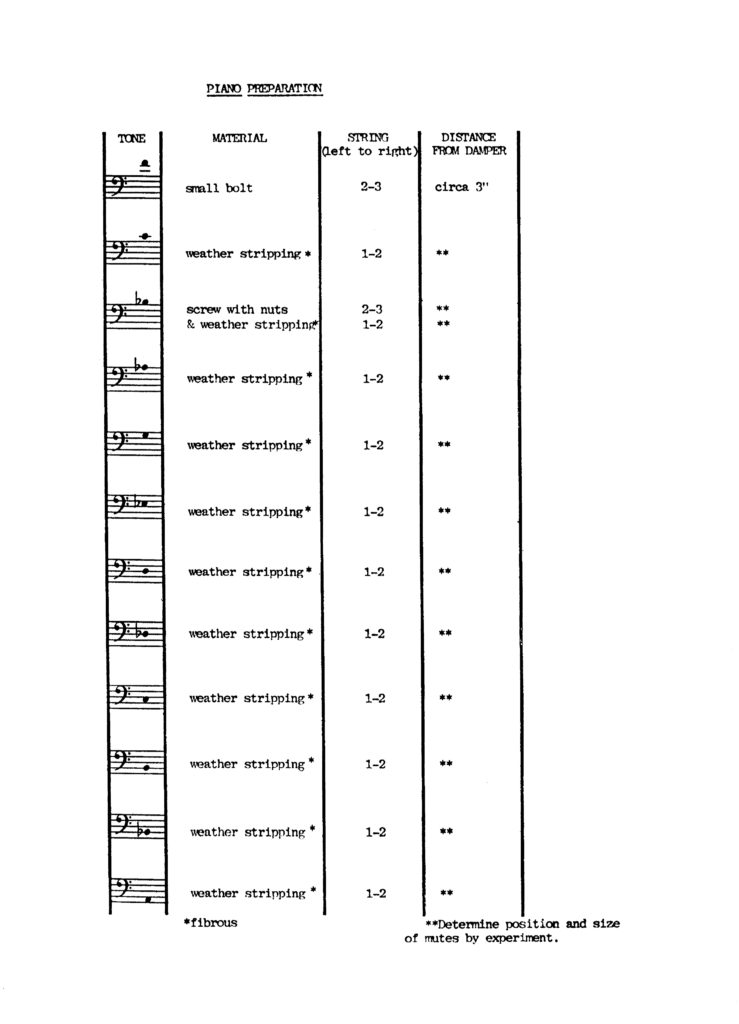Prepared Guitars – Bacchanale by Cage
- Contemporary Music, Ensemble, General, Recordings
- No Comments
Bacchanale by John Cage
Prepared Piano intoPrepared Guitars
Bacchanale was Cage’s first piece for prepared piano. Finding that the stage was too small for both dancer/choreographer Syvilla Fort and the needed battery of percussion, so Cage decided to fix weather stripping, bolts, screws and nuts into the strings of the piano to create a percussion ensemble, Fort, a colleague of Cage’s at Cornish College, asked for a composition of African inspiration. Only twelve notes are used in the piece, all of which are prepared. In the piano version preparation is predominantly weatherstripping and the performer is instructed to “determine position and size of mutes by experiment.
*click below to listen to Aaron & Adam Levin perform Bacchanale – track 14
Translating the preparations to the guitar posed a couple of challenges and I asked myself a few questions:
Q: Why prepare the strings at all, since the guitar will already not sound like a prepared piano?
A: I actually played the work completely as written with no preparations for a while. It fits on two guitars (guitar 1 = right hand, guitar 2 = left hand), without much adjustment, so I knew it was possible.
I was also not a big fan of prepared guitar with the works I had heard and seen in the past. At times I felt such works were more of an excuse to the performer to be seen as dramatic and serious. But, as I listened to more and more recordings of prepared piano and experienced the vast changes of timbre and percussion vs. piano sounds, I was inspired to experiment on my own.
Q: Isn’t guitar already considered a percussion instrument.
A: Yes and no. A flamenco guitar has a much lower action (strings closer to the fret board), which allows the strings to hit the frets when played apoyando (reststroke) or rasgueado (flamenco strumming). In such case, yes, it is both melody and percussion.
A classical guitar has a higher action (strings further from the fret board), which allows for more timbre choice, louder individual notes, more resonance, and depending on the player, cleaner tone.
These are broad generalizations, and do not say one is better than the other. Each guitar represents a very different style of music and artists are aware of it.
As a side note, a recording engineer I work with originally didn’t want to record guitar, because to him it just sounds like a box with strings. I convinced him otherwise.
Q: What are some of the challenges of preparing the guitar?
A: 1 – Gravity. If I clip something on to the strings and hold the guitar in the normal playing position those clips can easily flip towards the ground touching ‘higher’ strings or the wood of the soundboard. I also had to find a way to hold the substitute for weatherstripping in the strings without letting it fall out when being played.
2 – Only one string. Each note of the piano has three strings, so one can add a screw between two strings and not touch any other pitch.
3 – No slurs. Yes, if you do a left hand slur (hammer or pull off) the preparations don’t really sound.
4 – Nylon strings and no cast iron frame. Since the strings use much less tension weatherstripping will completely mute the string. I had to find a substitute that gave a percussive sound and a bit of pitch.
Q: When and where can I get the score?
A: Edition Peters will be publishing my arrangement in early 2019.

Piano Preparations

Guitar Preparations
Purchase the album on Amazon: http://a.co/d/1u6L6kk